Knitwit Twit...
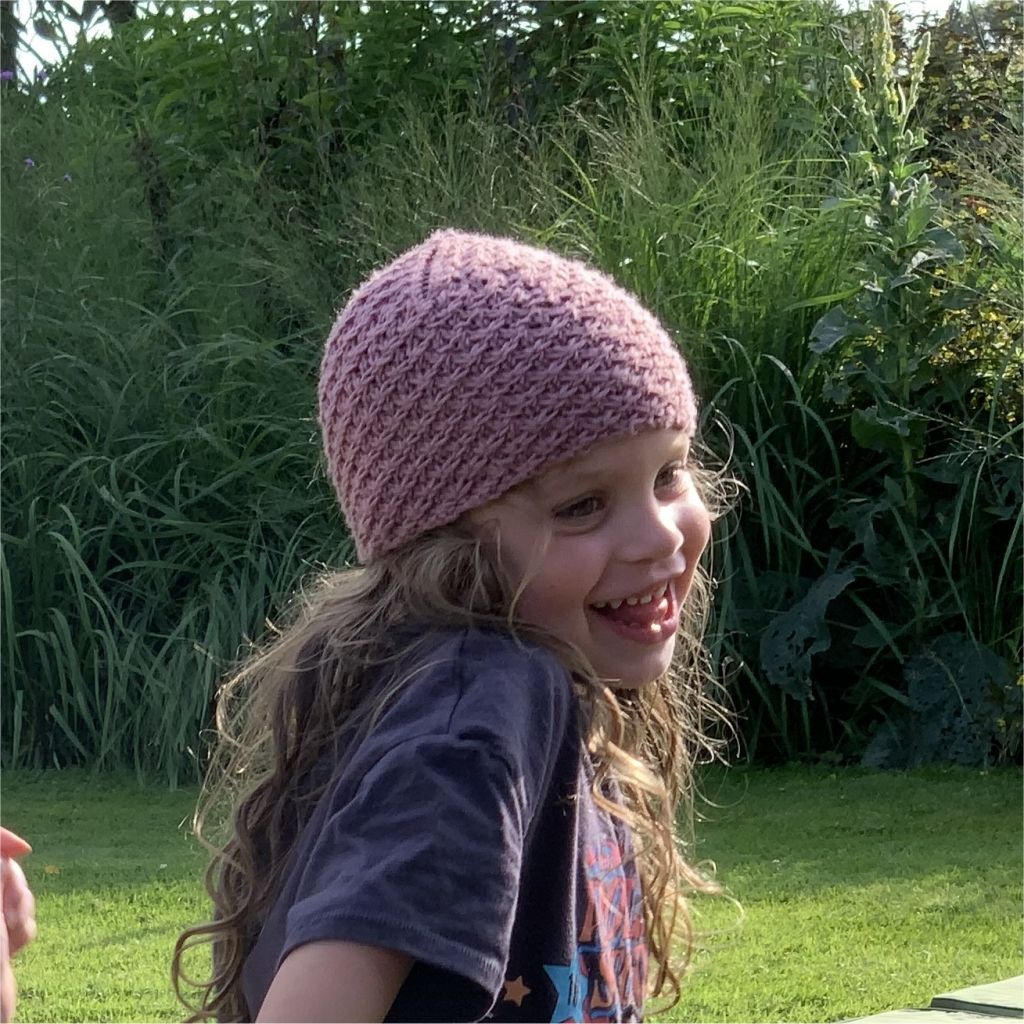
So I'm learning to knit - mostly for brain plasticity and to practice a new craft. I love it - my mates were all laughing - until Tom Daley was outed as a knitter at the Olympics - Oh and I saw a tweet of Patrick Stewart knitting in his Santa PJs too.
I'm about six months into my journey. I've watched a bunch of YouTubers, listened to several pod-casts, started following indie-dyers and knit-designers on Insta. I've googled for advice and direction on knit-learning - haven't found any good over-arching advice yet... just lots of individual techniques and how-to level things, hmmm.
I've joined Ravelry for patterns, and Etsy for yarn. I've discovered that KnitPro sell on Amazon in the UK - and are super expensive in Australia and New Zealand (gifts have been posted).
My stash has already escaped control - I have a box of options but not enough of any individual to create amazing things... and just Never Ever Enough https://bit.ly/3pM4OMU) time.
Words Unspoken
So there are a bunch of things I've discovered - but no-one else seems to say them out loud. At the risk of being knit-nerdy... my voyage of knit-newbie discovery has led me to...
Just Let Go
Relax - it's all about the tension! If you let your hands, neck, shoulders or mind tense up, your fabric tension goes haywire. Relax, chill, breathe, open your fingers up (don't use a closed grip), start humming, and knit dreaminess into your fabric. Make each stitch flow beautifully from your pins. Feel the movement of the yarn through your fingers and the stretch of your work as you knit. The best way to measure how you are doing seems to be by the ease of stitch movement along the needles. You want stitches to move easily, but not to have large loosey goosey loops.
On that note - does anyone else try and weave protection, love and warmth into their gifts? Who knows, perhaps the Buddhist meditative and repetitive chants actually do shape our reality! The grand-daughters have Pixie-protective charms woven into each stitch in their beanies, scarfs and gloves.
Practise Makes Project Purrfection
Choose practice projects for your 10,000 hours (1,333 days, 267 weeks, 6 years of work, Grasshopper!). Perhaps a series of scarfs... https://bit.ly/3Bpwzgm or https://bit.ly/3nB0spp - the patterns are so simple you can focus on learning the foo of knit. Knit them several times in different yarns, and on different size needles. Examine the results with your eyes and your fingers. Think about how to avoid or correct the tension issues, mistakes and errors. Check your results against the pictures - did you accidentally twist the working yarn around the slipped edge stitch?
Maybe scarfs are not your thing - perhaps you want to ebb and flow with increases and decreases? How about beanies? Woolly Wormhead is the go-to designer for all things in this head-space - https://bit.ly/3BnfbsE.
I've invested in a variety of cheerful yarns - cotton-bamboo, various weights of wool and mixes (Merino, Corriedale, BFL, Soay and Hebbridean), acrylic etc. - all specifically for practise knits. About 600m of each each seems plenty (more on sizes later).
Choose plain light colours initially so that you can see the stitch patterns easily. I've started specific projects as part of my 10,000 hours, and chosen simple things like swatches, interesting stitch-patterns, scarfs etc., all to practice the movements, sensations and recognition that goes into the craft of knitting.
I've also discovered it is possible to hypnotise kittens with working yarn.
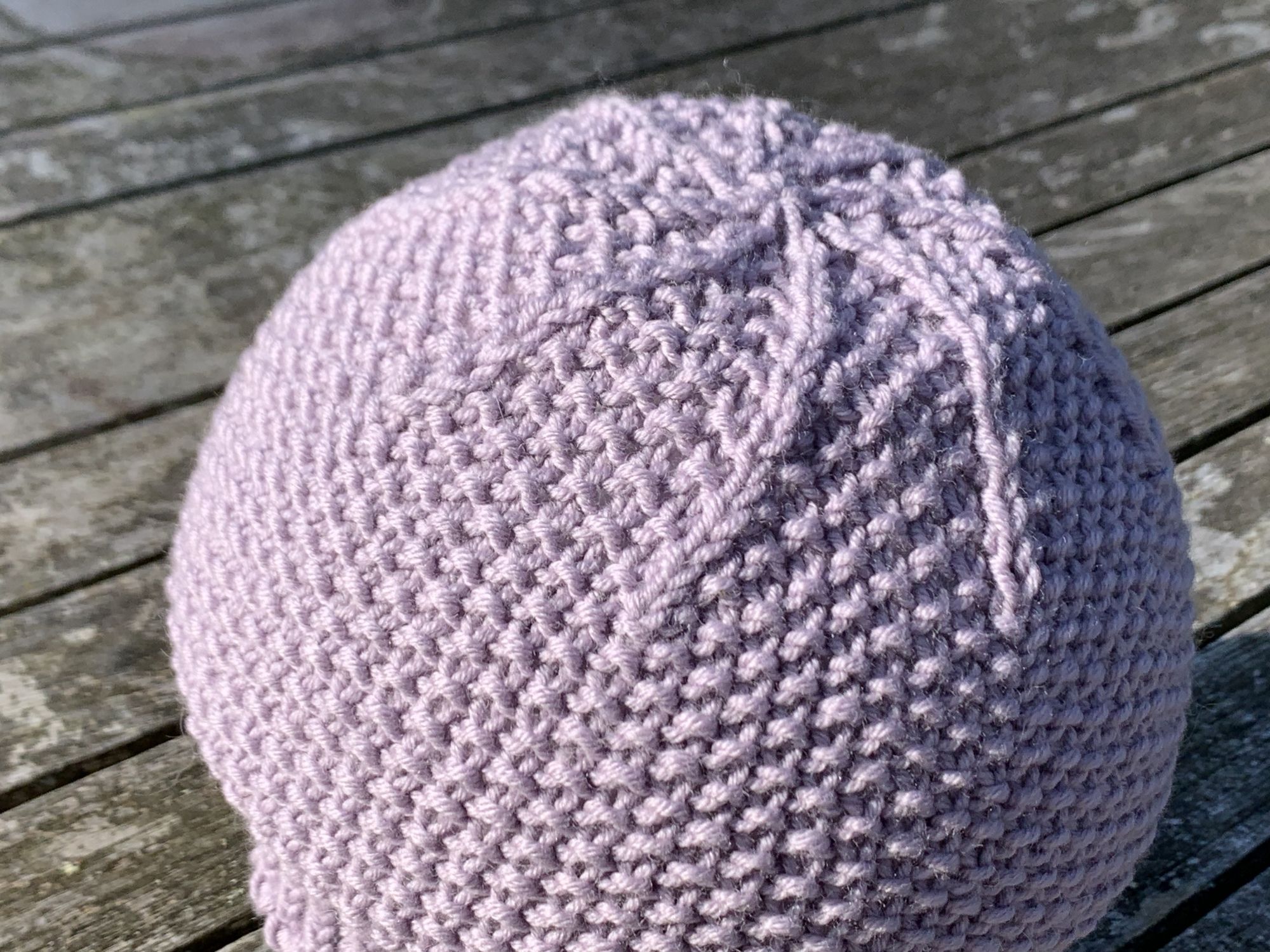
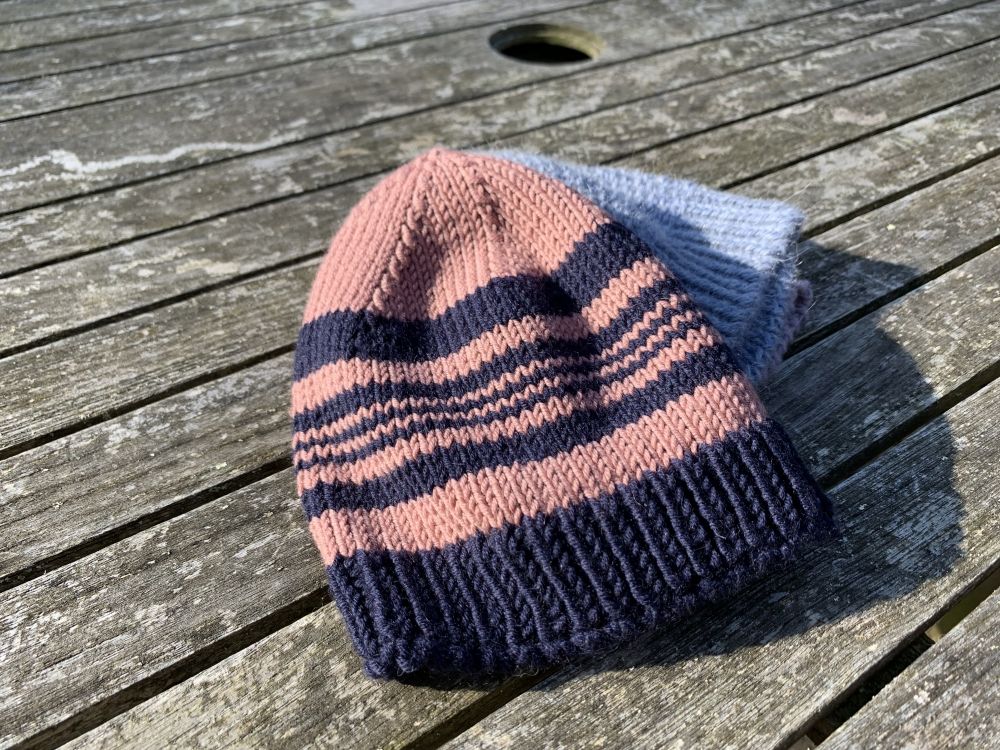
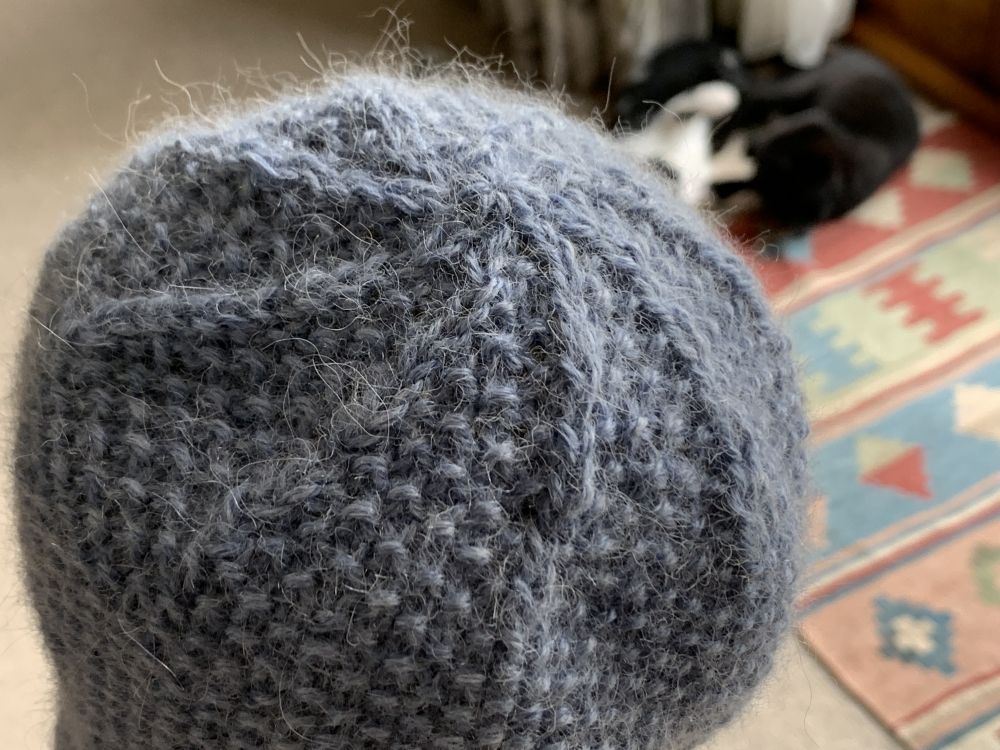
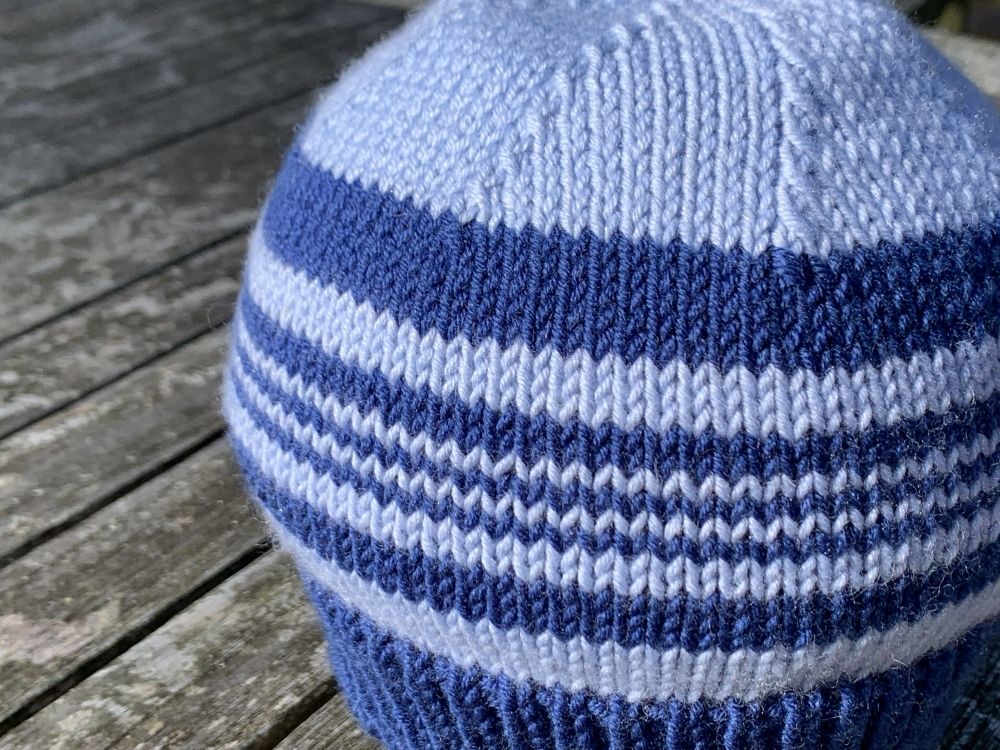
Weight What'cher Yarn
So there is huge variation in how yarn weight is described. You could put the effort into memorising how each different country describes their yarn. Is it Worsted, Aran, DK or Chunky? Maybe Fingering, Lace, Sport or Heavy Sock... and don't get confused when Worsted is both a weight, and a type of spin!
My current approach is to simply look at the weight and length - and use that to decide if I can substitute. My rule of thumb is:
- 100g of DK is about 250m long, 3.5mm - 5.0mm needles
- 100g of Aran is about 180m long, 4.5mm - 6.0mm needles
- 100g of Fingering is about 400m - knitting with two strands is like using DK
So how much is enough? It seems 500-700m of DK will make a decent length of 18cm wide scarf. Beanie? around 220m of DK. Balls often come in 50g or 100g, skeins usually 100g. Don't make the mistake of buying mini-skeins or you will be knitting dolly beanies. I think the minis are usually for a contrast.
A Rainbow of Colours
Look for amazing variation within a single skein from the Indie dyers on Etsy - but choose locals or you will end up paying a stack of postage.
High contrast is especially interesting - try it in something like Brioche stitch. Be bold rather than meh.
Lighter colours show interesting textures and stitch patterns better than darker colours. White is hard to find and match - as is black. Something to do with nature. I assume.
Shine, drape and fluffiness also change the look-and-feel. Drape is affected by the ratio of the yarn-weight and the needle diameter. Small diameter pins make a tighter and stiffer fabric - experiment! Fluffy yarns like mohair and cashmere require extra care not to split/divide the yarn as you knit.
Colour is wheely a whole topic for another day. I do miss the alpha-channel in the HSLA colour-verse though - is transparent a yarn colour?
Rich Resources
- YouTube - https://www.youtube.com/
- Ravelry - https://www.ravelry.com/
- Etsy - https://www.etsy.com/
- Amazon (UK) - https://www.amazon.co.uk
- Woolly Wormhead - https://www.woollywormhead.com/
- Patreon - https://www.patreon.com/
Snippity Snip Snippets
Find your Centre
Some folks don't like you pulling the working yarn from the centre of a cake, because it doesn't let the yarn release the twist it gets from being wound into a ball. I do it for every project - it does require some evisceration - but it is so much less frustrating than the terrible-tangles! And you don't need a ball-holder-bowl or bag etc. as your cakes stay put. Keep the yarn labels btw - yhbw! Hmmm - never tried knitting directly from a skein... something for the next practice project.
It's a Wrap
The direction that the yarn twists around the needles is the difference between Western and Oriental. If you point the tip of the pins towards you, Western knitting has the thread spiralled around the needle in a counter-clockwise direction - Oriental is wrapped the other way. Note that this is independent of which the side of the stitch the thread enters (that's the difference between knit and purl). Conceptually, knitting is the process of wrapping interlinked spirals of thread together, with the linkages being twisted either forward or backwards (knit or purl). I don't know if there is a third structure - where the spiral is an alternating wrap of clock-and-counter wise... something to try on a rainy day.
Doing The Continental
There are two main techniques for the actual process - English and Continental. (I'm right-handed - not sure how this changes for a leftie). My goal is to become fluent in both.
When knitting English, I hold the working yarn in my right hand and move my hand / index finger to loop the yarn around the needle. For knit: the wrap is under-over, and for purl it's over-under. I find that tension is easier to manage when knitting in English - as is control, so I use it for complex, awkward or new things, and situations where I seem to be dropping stitches. Sometimes coffee solves that problem too.
The Continental approach uses the left index-finger to hold the yarn above the needle. The right-hand moves the working needle through the stitch being worked, and twists the working yarn around it, then slips the stitch being worked off the left needle, leaving the new stitch on the right. The yarn moves much less, and the wrap of the yarn around the right needle is more noticeable. It takes more finesse - and I find it harder to maintain a consistent tension. My guess is that it will prove to be a much faster approach as hands, and the yarn make fewer and smaller movements.
I did find video online of the Shetland Island speed knitters who use a leather belt with holes to anchor the base of very long right-hand needles. They knit so fast that it is almost impossible to see what's happening with 1x playback. When you slow it down, it looks like a modification of the Continental approach - but one where the left needle is moved and the right is held almost fixed.
There's also a great short video on Insta of Woolly Wormhead knitting two colour rib - using Continental for the left-held colour and English for the right. I've also seen another chap on Insta that knits two colour Continental, with one colour on his left index -finger, and the other on his left middle-finger - dexterous!
Needles and Pins, Needles and Pins
Circulars are fun - there are 'normals' and 'specials'. Specials are shorter (4"), and used for knitting beanies, and tighter circles like sleeves and socks. Normals are a bit longer, and used for larger looped projects. I find magic-loop easier than multiple double-pointed needles when knitting the tight-loop crowns.
I've tried bamboo straights for practice - fun, and they grip the yarn gently making it easier to prevent slipped stitches. My favourite so far though are the KnitPro Zing series - which are silky lux metal needles, with a bit more slip. They come in straights, normals and specials, and are size-colour-coded. My default tension is a bit too tight, so metals make life a bit easier when I get carried away. https://amzn.to/3Evdcop.
Split Ends - and Middles
One of the common issues I have is splitting the yarn as I knit - especially for some of the fluffy yarns like mohair and cashmere. This creates unsightly thin loops, but more importantly it knots the yarn together creating an immovable point in the fabric. This means that when you block, the threads at this point cannot relax into a more even distribution - I'm working hard on eliminating this issue. As a side note, I've also found that three is the magic number - three stitches are enough to maintain shape and tension - so at tricky points, joins and edge cases, I'm extra careful with the tension on the first three stitches.
Casting On
Tubular Cast-on for 1x1 rib is beautiful and satisfying - but don't bother with complex provisional setup. This is the easiest way I've found to do it: https://bit.ly/3BhWxCJ. The knack with this is to keep the initial knit-purl cast-on stitches as tidy, consistent and aligned as possible - don't let them wind around the needle - as it can be hard to keep track of them if they twist.
The most interesting examination of how Tubular Cast-on is actually structured is: https://bit.ly/3ElN27i - even though her technique is more complex.
Edge Cases
Want a neat edge to your scarf? Knit the last stitch in the row, turn the work, slip one stitch purl-wise with the working yarn in the front. Move the working yarn to front or back as required for the next stitch. Take care when using Continental that you move the working yarn AFTER the slip and not wrapped across the leading edge of the slipped stitch - that road is bumpy!
Mental Block
There is not much detailed information on blocking - a few videos, but I've not found any interesting ones yet. Very Pink does talk about blocking beanies. I've discovered that a pudding bowl (empty!) balanced on a tall Sistema is a perfect for drying beanies.
Took me a while to discover that you are supposed to SOAK the work for a period of time (1/2 to 1 hr) apparently to get the air out of the fibre.
Not sure I really buy this - my experience indicates that the fibres get pretty damp and smooth out (i.e. get less fluffy) immediately. This seems to let them slide and slip sideways a little in the fabric, evening out stitch size and tension variations. The real key seems to actually be in pulling the cool water through the fabric gently, in various directions, without too much stretching, and avoiding matting and felting. It feels like it's actually the smoothness of the fibre allowing the stitches to move, and the presence and weight of the water gently flowing through that eases out all the wrinkles.
The drying is also important - patting between the folds of a towel rather than wringing, and then positioning / laying the work into the desired final shape while is dries. I do see that folks spend on blocking mats which have grids to enable pinning into alignment - haven't got that far in my journey yet.
And so to bed...
This is my initial random 10pm brain-dump - more to come in another post, but first - dream-time.